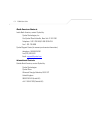
GL-3
Full-duplex A system that allows packets to be transmitted and received at the same time and,
in effect, doubles the potential throughput of a link.
Half-duplex A system that allows packets to transmitted and received, but not at the same time.
Contrast with full-duplex.
IEEE Institute of Electrical and Electronics Engineers. This American organization was
founded in 1963 and sets standards for computers and communications.
IETF Internet Engineering Task Force. An organization responsible for providing
engineering solutions for TCP/IP networks. In the network management area, this
group is responsible for the development of the SNMP protocol.
IGMP Internet Group Management Protocol, the standard for IP multicasting in the Internet.
IGMP is used to establish host memberships in multicast groups on a single network.
(See IP multicast)
IP Internet Protocol. IP is a layer 3 network protocol that is the standard for sending data
through a network. IP is part of the TCP/IP set of protocols that describe the routing
of packets to addressed devices.
IP address Internet Protocol address. A unique identifier for a device attached to a network using
TCP/IP. The address is written as four octets separated with periods (full-stops), and
is made up of a network section, an optional subnet section and a host section.
IP multicast Sending data to distributed servers on a multicast backbone. For large amounts of
data, IP Multicast is more efficient than normal Internet transmissions, because the
server can broadcast a message to many recipients simultaneously. Unlike traditional
Internet traffic that requires separate connections for each source-destination pair, IP
multicasting allows many recipients to share the same source. This means that just
one set of packets is transmitted for all the destinations.
LAN Local Area Network. A network of end stations (such as PCs, printers, servers) and
network devices (hubs and switches) that cover a relatively small geographic area
(usually not larger than a floor or building).
Load balancing The ability to distribute traffic across various ports of a device, such as a switch, to
provide efficient, optimized traffic throughout the network.
Loop An event that occurs when two network devices are connected by more than one
path, thereby causing packets to repeatedly cycle around the network and not reach
their destination.
MAC Media Access Control. A protocol specified by the IEEE for determining which devices
have access to a network at any one time.
MAC address Media Access Control address; also called hardware or physical address. Most
devices that connect to a LAN have a MAC address assigned to them, as they are
used to identify other devices in a network.


















